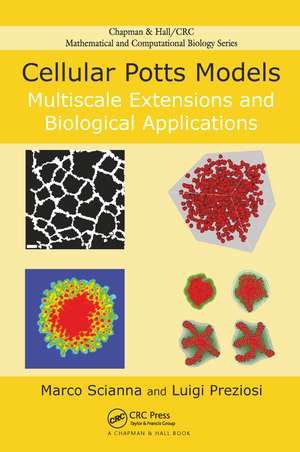Cellular Potts Models: Multiscale Extensions and Biological Applications: Chapman & Hall/CRC Mathematical Biology Series
Autor Marco Scianna, Luigi Preziosien Limba Engleză Hardback – 26 mar 2013
The book first explains the biophysical bases, main merits, and limitations of the cellular Potts model. It then proposes several innovative extensions, focusing on ways to integrate and interface the basic cellular Potts model at the mesoscopic scale with approaches that accurately model microscopic dynamics. These extensions are designed to create a nested and hybrid environment, where the evolution of a biological system is realistically driven by the constant interplay and flux of information between the different levels of description. Through several biological examples, the authors demonstrate a qualitative and quantitative agreement with the relative experimental data.
The cellular Potts model is increasingly being used for the mathematical modeling of a wide range of biological phenomena, including wound healing, tumor growth, and cancer cell migration. This book shows how the cellular Potts model can be used as a framework for model building and how extended models can achieve even better biological practicality, accuracy, and predictive power.
Preț: 738.43 lei
Preț vechi: 1028.61 lei
-28% Nou
Puncte Express: 1108
Preț estimativ în valută:
141.30€ • 147.90$ • 117.61£
141.30€ • 147.90$ • 117.61£
Comandă specială
Livrare economică 10-24 martie
Doresc să fiu notificat când acest titlu va fi disponibil:
Se trimite...
Preluare comenzi: 021 569.72.76
Specificații
ISBN-13: 9781466514782
ISBN-10: 1466514787
Pagini: 300
Ilustrații: 118 b/w images, 19 color images and 11 tables
Dimensiuni: 156 x 234 x 23 mm
Greutate: 0.57 kg
Ediția:1
Editura: CRC Press
Colecția Chapman and Hall/CRC
Seria Chapman & Hall/CRC Mathematical Biology Series
ISBN-10: 1466514787
Pagini: 300
Ilustrații: 118 b/w images, 19 color images and 11 tables
Dimensiuni: 156 x 234 x 23 mm
Greutate: 0.57 kg
Ediția:1
Editura: CRC Press
Colecția Chapman and Hall/CRC
Seria Chapman & Hall/CRC Mathematical Biology Series
Public țintă
Mathematical biologists, biophysicists, and biomedical engineers.Cuprins
I Basic Cellular Potts Model and Applications: Basic CPM. HGF-Induced Cell Scatter. Mesothelial Invasion of Ovarian Cancer. II Extended Cellular Potts Model and Applications: Extended Cellular Potts Model. Wound Healing Assay. Effect of Calcium-Related Pathways on Single Cell Motility. Tumor-Derived Vasculogenesis. Different Morphologies of Tumor Invasion Fronts. Cell Migration in Extracellular Matrices. Cancer Cell Migration in Matrix Microchannels. Appendices. Bibliography. Index.
Notă biografică
Marco Scianna is a post-doctoral fellow in the Department of Mathematical Sciences at the Politecnico di Torino. He earned a Ph.D. in complex systems in post-genomic biology from the University of Turin. His principal research focuses on mathematical multiscale models applied to biological and biomedical problems, with particular interest in the context of tumor growth, vascular network formation, and cell migration in extracellular matrix.
Luigi Preziosi is a professor of mathematical physics at the Politecnico di Torino. He earned a Ph.D. in mechanics from the University of Minnesota and in mathematics from the University of Naples. He has authored three books, more than 30 book chapters, and more than 100 articles in international journals. His recent research interests include multiphase models of tumor growth, the mechanics of tissue growth and regenerations, cell migration, and vascular network formation.
Luigi Preziosi is a professor of mathematical physics at the Politecnico di Torino. He earned a Ph.D. in mechanics from the University of Minnesota and in mathematics from the University of Naples. He has authored three books, more than 30 book chapters, and more than 100 articles in international journals. His recent research interests include multiphase models of tumor growth, the mechanics of tissue growth and regenerations, cell migration, and vascular network formation.
Descriere
This work shows how the cellular Potts model can be used as a framework for model building and how extended models can achieve even better biological practicality, accuracy, and predictive power. It focuses on ways to integrate and interface the basic cellular Potts model at the mesoscopic scale with approaches that accurately model microscopic dynamics. These extensions are designed to create a nested and hybrid environment, where the evolution of a biological system is realistically driven by the constant interplay and flux of information between the different levels of description.













